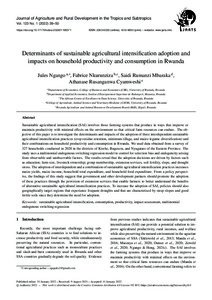| dc.date.accessioned | 2022-02-01T10:01:55Z | |
| dc.date.available | 2022-02-01T10:01:55Z | |
| dc.date.issued | 2022-01-31 | |
| dc.identifier | doi:10.17170/kobra-202201195571 | |
| dc.identifier.uri | http://hdl.handle.net/123456789/13581 | |
| dc.language.iso | eng | |
| dc.rights | Namensnennung 4.0 International | * |
| dc.rights.uri | http://creativecommons.org/licenses/by/4.0/ | * |
| dc.subject | sustainable agricultural intensification | eng |
| dc.subject | consumption | eng |
| dc.subject | productivity | eng |
| dc.subject | impact assessment | eng |
| dc.subject | multinomial endogenous switching regression | eng |
| dc.subject.ddc | 630 | |
| dc.title | Determinants of sustainable agricultural intensification adoption and impacts on household productivity and consumption in Rwanda | eng |
| dc.type | Aufsatz | |
| dcterms.abstract | Sustainable agricultural intensification (SAI) involves those farming systems that produce in ways that improve or maintain productivity with minimal e ects on the environment so that critical farm resources can endure. The objective of this paper is to investigate the determinants and impacts of the adoption of three interdependent sustainable agricultural intensification practices (crop residue retention, minimum tillage, and maize-legume diversification) and their combinations on household productivity and consumption in Rwanda. We used data obtained from a survey of 327 households conducted in 2020 in the districts of Kirehe, Bugesera, and Nyagatare of the Eastern Province. The study uses a multinomial endogenous switching regression model to control for selection bias and endogeneity arising from observable and unobservable factors. The results reveal that the adoption decisions are driven by factors such as education; farm size, livestock ownership; group membership, extension services, soil fertility, slope, and drought stress. The adoption of interdependent and a combination of sustainable agricultural intensification practices increases maize yields, maize income, household total expenditure, and household food expenditure. From a policy perspective, the findings of this study suggest that government and other development partners should promote the adoption of these practices through the provision of extension services that enable farmers to better understand the benefits of alternative sustainable agricultural intensification practices. To increase the adoption of SAI, policies should also geographically target regions that experience frequent droughts and that are characterised by steep slopes and good fertile soils since they determine the need for adoption. | eng |
| dcterms.accessRights | open access | |
| dcterms.creator | Ngango, Jules | |
| dcterms.creator | Nkurunziza, Fabrice | |
| dcterms.creator | Rumanzi, Mabaraka Saidi | |
| dcterms.creator | Cyamweshi, Rusanganwa Athanase | |
| dc.subject.swd | Nachhaltigkeit | ger |
| dc.subject.swd | Landwirtschaft | ger |
| dc.subject.swd | Intensivlandwirtschaft | ger |
| dc.subject.swd | Verbrauch | ger |
| dc.subject.swd | Produktivität | ger |
| dc.type.version | publishedVersion | |
| dcterms.source.identifier | eissn:2363-6033 | |
| dcterms.source.issue | No. 1 | |
| dcterms.source.journal | Journal of Agriculture and Rural Development in the Tropics and Subtropics (JARTS) | eng |
| dcterms.source.pageinfo | 39-50 | |
| dcterms.source.volume | Vol. 123 | |
| kup.iskup | false | |


